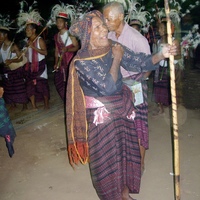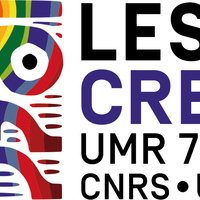Deprecated: strpos(): Passing null to parameter #1 ($haystack) of type string is deprecated in /var/www/html/themes/BBCFoundation/view/omeka/site/item/show.phtml on line 31
Deprecated: strpos(): Passing null to parameter #1 ($haystack) of type string is deprecated in /var/www/html/themes/BBCFoundation/view/omeka/site/item/show.phtml on line 45
(Flores Waiklibang) Mitos Asal Usul Padi, Tarian Nama Nigi, 3
Field recording collected by Dana Rappoport in Eastern Indonesia in 2006 and 2007
- Edited Title
- Archivist's Original Title
- Original description
- Time duration
- Recording date of the original material
- Acquisition Date
- Population
- Place of the cultural origin
- Country Name
- Recording place
- Resource Language
- Performer/Speaker
- Comment
- Archivist Category
- Recording context
- Instrument, Original Archivist Data
- Instrument (Supplementary/Annotated Data)
- Collector
- Name of original Collection
- Collection source citation
- History of ownership
- Holding Institution of Original Materials
- Licensing Institution
- Accessing Institutions
- Copyright Information
- Copyright Notice
- Physical format
- Preservation State of Physical Object
- Original item number
- SEAH Identifier
-
Nama Nigi- Haman Opak bélun: Gurun Gawak Be'ola Tugu "narrative of enveloping and encircling the food of the fields"
-
id
(Flores Waiklibang) Mitos Asal Usul Padi, Tarian Nama Nigi, 3
-
en
(Flores Waiklibang) Sung Myth of The Origin Of Rice, Nama Nigi Dance, 3
-
fr
(Flores Waiklibang) Mythe d'Origine Du Riz (3). Danse Nama nigi
-
en
Field recording collected by Dana Rappoport in Eastern Indonesia in 2006 and 2007
-
id
Rekaman dibuat oleh Dana Rappoport di Indonesia Timur selama satu tahun (2006-2007)
-
fr
Enregistrements de Dana Rappoport dans l'Est indonésien durant un an (2006-2007)
-
00:18:18
-
2006-11-08
-
2007
-
Lamaholot
-
Flores, Waiklibang, Kec. Tanjung Bunga, Kabupaten Flores Timur
-
Lamaholot
-
Klara Kési Liwun, Ema' Kewe, Lego Lego Koten, Johanes Milan Maran, Andreas Ama Maran and other Waiklibang singers.
-
en
Recorded during the Dokan Gurun ritual. Recorded the night of November 8, 2006, at 2 am, in Ratulodong (Desa Waiklibang), on the occasion of the agrarian ritual Dokan Gurun (“seed wrapping”). Haman Opak bélun: Gurun Gawak Be'ola Tugu "narrative of enveloping and encircling the food of the fields" . Nama nigi "difficult dance" (from haman "tread" and nigin "difficult") unfolds over a rhythmic cycle of sixteen beats marked by the steps of the dancers. During this cycle, the singers alternate three melodic motifs, shared between two groups of duettists (opak and hodé'ana).The pitch scale is tetraphonic (re mi fa sol). The “difficulty” (nigin) lies in the coordination between the cycle of sixteen beats marked by the dance steps and the melodic motifs. The song functions on an alternation between reciter (opak) and alternating duet (hode' ana') Alternation between two duets: two women and two men. The second voice in the duet sings a fifth below the first. The second voice is a drone. The Dokan Gurun ("save, set aside, wrap") rite is done to store the seed in the granary. This seed represents the body of a sacrificed woman.
-
fr
Nama nigi « danse difficile » (de haman « fouler » et nigin « difficile ») se déploie sur un cycle rythmique de seize temps marqués par les pas des danseurs. Sur ce cycle, les chanteurs alternent trois motifs mélodiques, partagés entre deux groupes de duettistes (opak et hodé’ ana). Au sein d'un duo, la seconde voix chante à la quinte inférieure, comme un bourdon . L’échelle de hauteurs est tétraphonique (ré mi fa sol). La « difficulté » (nigin) réside dans la coordination entre le cycle de seize temps marqués par les pas de danse et les motifs mélodiques. Le chant fonctionne sur une alternance entre récitant (opak) et duo alternant (hode' ana') Alternance entre deux duos : deux femmes et deux hommes.
-
id
Nama nigi “tarian sulit” (dari haman “menginjak” dan nigin “sulit”) berlangsung dalam siklus ritmis enam belas ketukan yang ditandai oleh langkah para penari. Dalam siklus ini, para penyanyi bergantian membawakan tiga motif melodi, yang dibagi antara dua kelompok duet (opak dan hodé’ ana). Setiap penyulam bernyanyi di bagian kelima bawah. Tangga nada bersifat tetrafonik (D E F G). "Kesulitan" (nigin) terletak pada koordinasi antara siklus enam belas ketukan yang ditandai dengan langkah-langkah tari dan motif melodi. Lagu ini menggunakan pergantian antara pencerita (opak) dan duet bergantian (hode' ana'). Pergantian antara dua duet: dua wanita dan dua pria.
-
en
Music (Vocal and instrumental)
-
en
Field recording
-
Singing Voice: Female duet, male duet
-
Bells
-
Indonesia : East Flores, Solor, Adonara, Lembata Islands, 2006-2007.
-
Sound recording archived at Musée de l'Homme in 2007 by D. Rappoport
-
In Copyright. Non-Commercial Use Permitted
-
For any use, please contact the CREM-LESC (CNRS, Nanterre University, France): crem.lesc[at]cnrs.fr ; See information at https://archives.crem-cnrs.fr
-
en
Digital file
-
original
-
CNRSMH_I_2007_006_001_235
-
SEAH_CNRSMH_I_2007_006_001_235
- Item sets
Linked resources
| Title | Class |
|---|---|
 https://archives.crem-cnrs.fr/archives/items/CNRSMH_I_2007_006_001_235 https://archives.crem-cnrs.fr/archives/items/CNRSMH_I_2007_006_001_235 |
AudioObject |





